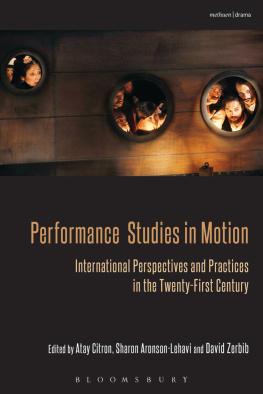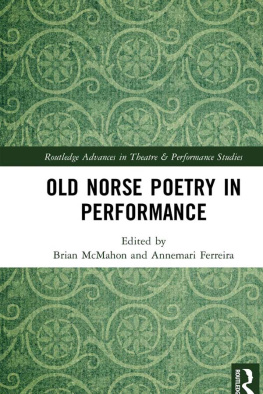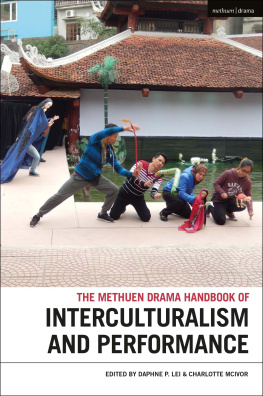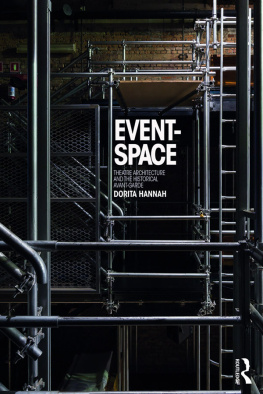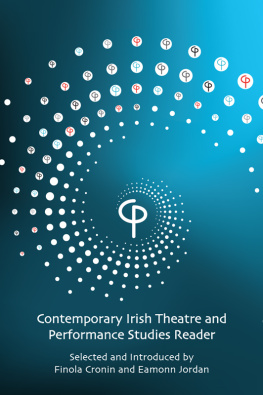Creating and editing this book is the result of a fruitful and inspiring dialogue with many colleagues and friends to whom we are deeply grateful. The idea for Performance Studies in Motion originates in the lively presentations and discussions that took place during the 2010 international conference RS & PS: Richard Schechner and Performance Studies . In the conference that took place at the University of Haifa, artists and scholars from 12 countries gathered to honour performance studies pioneer Richard Schechner and to discuss current issues in the field. This event led us to embark on this book project, which examines performance studies with a look into the future, and we are therefore indebted first and foremost to all those who participated and presented their research at the conference. We are especially grateful to members of the academic committee: Jeanette Malkin, Carol Martin and Nurit Yaari. We are equally grateful to members of the organizing committee: Sarit Cofman-Simhon, Dror Harari and Olga Levitan, as well as to production assistant Adva Weinstein, and to the Theatre Department and Faculty of the Humanities at the University of Haifa.
The process of editing the book was based on an ongoing and stimulating exchange of ideas, thoughts and feedbacks. We are deeply grateful to Carol Martin for her good advice along the way. We would also like to thank all the contributors for the cooperative, instructive and pleasant dialogue. Thanks to them and their careful attention in taking into account our tripolar cross-readings, this project has led us through an intense process of collective thinking and an enriching pluralist debate.
This book could not be realized without the enthusiastic and professional support of Mark Dudgeon at Bloomsbury Methuen Drama and we are deeply grateful to him. We are also extremely grateful to Emily Hockley and to the entire editorial staff at Methuen.
For enabling us the time and inspiration during this creative process, we are deeply grateful to our families. Atay Citron dedicates this book to Anat and Yael with much love. Sharon Aronson-Lehavi dedicates it with love to Amnon and Lia. David Zerbib dedicates it to little Eva, who was born during the project, to Milan who often agreed to delay soccer games, and to Valentina for her legendary patience.
Throughout the laborious process, we were all inspired by Richards vision, and it is with much love and gratitude that we dedicate this volume to him.
David Zerbib
The theatre was taken in by the Church in the Middle Ages, then some time around the Renaissance it was emancipated, or thrown out from the Church, whence it was taken in by literature; and I think in these last few days its being thrown out by literature. Roland Barthes, Jacques Lacan and Jacques Derrida.
Yet, this event also needs to be situated within the genealogy of performance studies. In 1966, this original field of research had not been invented. One of its future founders, who would define it as being wide open,the opening of a field and the setting in motion of an object whose movement indeed is a part of its intrinsic nature.
The Johns Hopkins University meetings shed light on a key dimension of this movement. Up to and including the inaudible question of performance which does not receive an explicit answer in this context, they highlight a fundamental issue for its contemporary theory and practice: the relationship paradoxical because despite obviously being semantically close it is often contradictory between embodied performance and textual performativity. What was being looked for and announced on this epic stage of intellectual life, symptomatically through Schechners fringe speeches between lectures, as the one we quoted at the outset of this essay, was the linkage between at least two falsely converging paths of the performative turn : from one side, some philosophical operations leading to the discovery at the core of language, with Derrida, a breach which weakens its link to truth and meaning in favour of a free play of signs; from the other side, a dismissal of the text itself building on the stage of bodies and gestures a literal space of individual and collective transformation.
Against a backdrop of misunderstanding, however, a common dynamic rose up in the watershed years 196668 between these paths of the performative turn. Its figure was Dionysus, the god of drunkenness, trance and excess, invoked in a variety of modes and rites, and who at least since Euripides has been in the habit of taking on the features of numerous heroes in this historical tragedy that has consisted in opening up the scene of an end to representation, in literary criticism, philosophy and even the theatre. Dionysus has largely given the measure, in both the rhythmic and evaluative senses of the word, to the performances played out there in the practical and theoretical field. This measure, derived from Dionysian hubris , records the immoderation of transformations, and is first of all an indicator of force. Now, it is precisely in a certain play between forms and forces that the aforementioned two paths of the performative turn seem able to link together.
Symptom
The reference to the symptomatic presence of the question of the performance in this event devoted to literary criticism and to the sciences of man has a double meaning: in the sense of a meaningful indicator referring to the general balance of an organization, if not of an organism, in which the future of the City of the Humanities in the United States is played out, a stage with its chorus, its heroes announcing the new age, its battles of ideas and its messengers arriving from the Paris left bank. But, the symptomatic question also has the meaning of one brand of philosophy, which sees the theatre as the place for an etiology of language, of a disease affecting the ordinary workings of our utterances.
Schechner was not at Harvard when John L. Austin gave his famous lectures in 1955, published in 1962 with the title How to do things with words. But Austin answered the question of the theatre. We know indeed that the discoverer of performativity, that active property of language whereby words produce deeds instead of merely noting, describing or representing reality, paradoxically excluded from his analysis the declamations of the actor on stage.
As utterances our performatives are also heir to certain other kinds of ill which infect all utterances... I mean, for example, the following: a performative utterance will, for example, be in a peculiar way hollow and void if said by an actor on the stage. In fact, explains Austin, language in such circumstances is used not seriously, but in ways parasitic upon its normal useways which fall under the doctrine of the etiolations of language.
The question of the performance is a distraction even within the performative turn. Thus, there exists a performative circumstance that the theory of performativity considers from the outset as a source of infection, a cause of malfunctions and pragmatic indeterminacy: artistic performance in general and theatrical performance in particular. For, we do understand that art forces us to rethink the criteria of the effectiveness of language above and beyond the conventions of ordinary language. In art, we might say in Austins terms, the perlocutory force of utterances (i.e. the measure of the effects that they produce by the very fact of their performance) lies in their ability to suspend the social and conventional conditions of meaning, making possible their momentary or lasting transformations. That is why, for example, the earth is blue like an orange.
Admittedly, mention of Austin sheds light on another path taken by the performative turn, which was basically only marginally present at Johns Hopkins in 1966. Macksey quotes Wittgenstein, who then tells us through this enigmatic formula that a language is only understandable provided the speakers form of life and worldview is familiar. But this implies an image of the language-game operating as the circus games, in a tension between pure forces and language, with a risk of devouring, exhibiting a symbol of force to illustrate the question of meaning.
Next page
